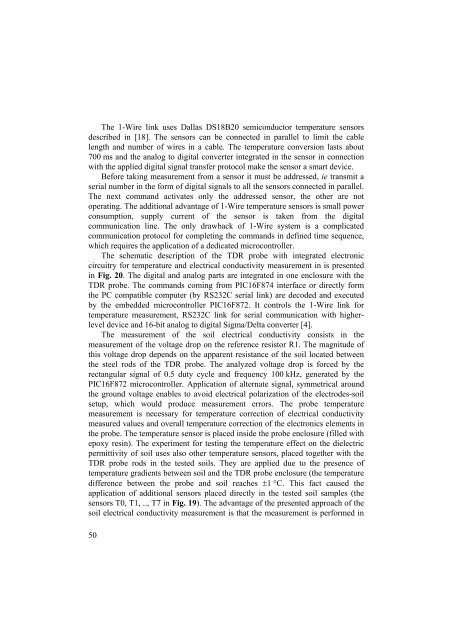ekS - Instytut Agrofizyki im. Bohdana DobrzaÅskiego PAN w Lublinie ...
ekS - Instytut Agrofizyki im. Bohdana DobrzaÅskiego PAN w Lublinie ...
ekS - Instytut Agrofizyki im. Bohdana DobrzaÅskiego PAN w Lublinie ...
Create successful ePaper yourself
Turn your PDF publications into a flip-book with our unique Google optimized e-Paper software.
The 1-Wire link uses Dallas DS18B20 semiconductor temperature sensors<br />
described in [18]. The sensors can be connected in parallel to l<strong>im</strong>it the cable<br />
length and number of wires in a cable. The temperature conversion lasts about<br />
700 ms and the analog to digital converter integrated in the sensor in connection<br />
with the applied digital signal transfer protocol make the sensor a smart device.<br />
Before taking measurement from a sensor it must be addressed, ie transmit a<br />
serial number in the form of digital signals to all the sensors connected in parallel.<br />
The next command activates only the addressed sensor, the other are not<br />
operating. The additional advantage of 1-Wire temperature sensors is small power<br />
consumption, supply current of the sensor is taken from the digital<br />
communication line. The only drawback of 1-Wire system is a complicated<br />
communication protocol for completing the commands in defined t<strong>im</strong>e sequence,<br />
which requires the application of a dedicated microcontroller.<br />
The schematic description of the TDR probe with integrated electronic<br />
circuitry for temperature and electrical conductivity measurement in is presented<br />
in Fig. 20. The digital and analog parts are integrated in one enclosure with the<br />
TDR probe. The commands coming from PIC16F874 interface or directly form<br />
the PC compatible computer (by RS232C serial link) are decoded and executed<br />
by the embedded microcontroller PIC16F872. It controls the 1-Wire link for<br />
temperature measurement, RS232C link for serial communication with higherlevel<br />
device and 16-bit analog to digital Sigma/Delta converter [4].<br />
The measurement of the soil electrical conductivity consists in the<br />
measurement of the voltage drop on the reference resistor R1. The magnitude of<br />
this voltage drop depends on the apparent resistance of the soil located between<br />
the steel rods of the TDR probe. The analyzed voltage drop is forced by the<br />
rectangular signal of 0.5 duty cycle and frequency 100 kHz, generated by the<br />
PIC16F872 microcontroller. Application of alternate signal, symmetrical around<br />
the ground voltage enables to avoid electrical polarization of the electrodes-soil<br />
setup, which would produce measurement errors. The probe temperature<br />
measurement is necessary for temperature correction of electrical conductivity<br />
measured values and overall temperature correction of the electronics elements in<br />
the probe. The temperature sensor is placed inside the probe enclosure (filled with<br />
epoxy resin). The exper<strong>im</strong>ent for testing the temperature effect on the dielectric<br />
permittivity of soil uses also other temperature sensors, placed together with the<br />
TDR probe rods in the tested soils. They are applied due to the presence of<br />
temperature gradients between soil and the TDR probe enclosure (the temperature<br />
difference between the probe and soil reaches ±1 °C. This fact caused the<br />
application of additional sensors placed directly in the tested soil samples (the<br />
sensors T0, T1, .., T7 in Fig. 19). The advantage of the presented approach of the<br />
soil electrical conductivity measurement is that the measurement is performed in<br />
50
















